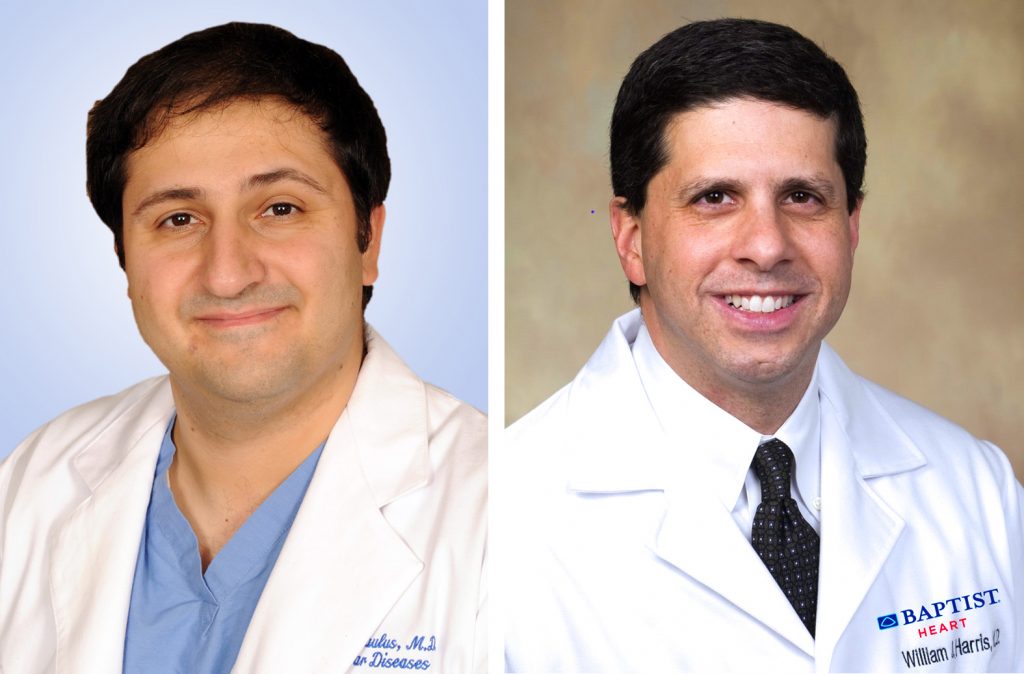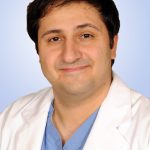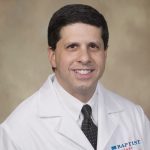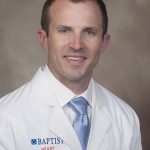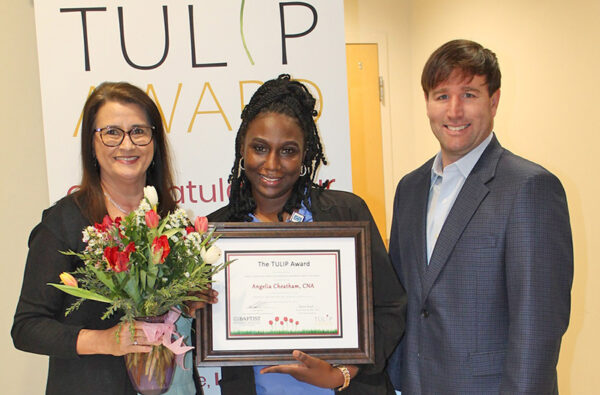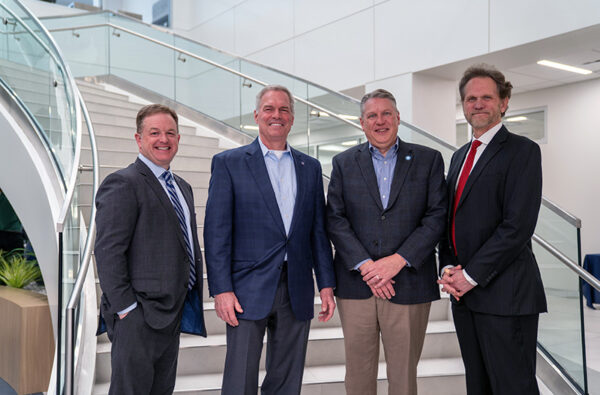Not so long ago, patients with severe valve disease who were high risk for open-heart surgery had no options and a poor prognosis. A minimally invasive heart procedure called transcatheter aortic valve replacement (TAVR) changed everything for these patients and ultimately made life easier for low- and moderate-risk heart patients, as well.
This year marks the 10-year anniversaries of the first TAVR procedures performed at Baptist Memphis and Mississippi Baptist Medical Center (MBMC). The first TAVR procedure at Baptist Memphis was performed on February 9, 2012, while the first TAVR procedure at MBMC was performed on July 5, 2012.
To learn more about these exciting TAVR journeys, we talked with Basil Mantas Paulus, MD, with Stern Cardiovascular in Memphis and William J. Harris, III, MD, with Baptist Heart in Jackson, Mississippi. They’ve been there with the valve teams from the beginning and helped form the TAVR programs. We also spoke with other members of the valve team at Baptist Heart: valve coordinator Lynne C. Currie, DNP, CFNP, and interventional cardiologist Ross Thurmond, DO.
Could you tell us more about TAVR and your valve team?
Dr. Harris:
It’s been interesting to watch this technology evolve rapidly over a short period of time, and it’s almost impossible to predict where it’ll be five or 10 years from now. It’s likely going to keep getting better. It’s not for everybody, but it’s a very good and useful tool to have in our armamentarium. There was a time when we might open patients for cases and realize after we got in there that there was no option for that patient, and we closed them back up. Now it’s nice to have more options to treat patients. TAVR is improving quality of life and longevity by giving us the ability to treat aortic stenosis in more patients.
Our valve team includes our valve coordinator Lynne Currie, DNP, CFNP; W. Stewart Horsley, MD, a surgeon on our team; Laura Tran, RN, who works with me and Dr. Horsley; cardiologists Ross Thurmond, DO; W. Hampton Jones, III, MD; H. Chris Waterer, III, MD; and Shawn W. Sanders, MD. This summer, a structural heart specialist will join our team.
Dr. Paulus:
TAVR procedures are performed with cardiologists, surgeons, anesthesiologists, echocardiographers, doctors and nurses. The valve team was set up so we could have a team of experts to deal with valvular heart disease with a more thoughtful and multi-disciplinary approach and give the best possible care. Now is a good time to celebrate the whole program. It has really grown and blossomed from 10 years ago.
Our valve team includes Melissa Barnes, NP; Dana Gann, RN; valve coordinators – Elizabeth Huey, RN and Lauren Murphy, RN; the other interventional cardiologists in the program who perform TAVR – Shankho Ganguli, MD and Gilbert Zoghbi, MD; and the surgeons who perform TAVR – Brad Wolf, MD; John Craig, MD; and Ed Garrett, MD.
Dr. Thurmond:
I can remember being at medical school when the partner trial was published in 2010 and having no idea what kind of game-changing impact that TAVR would have. It’s fascinating that it’s already been an available option here for 10 years.
Prior to TAVR, there was no option for patients with severe valve disease who were considered high risk for surgery. They basically had a decline in function and ultimately a poor prognosis. With TAVR, we’ve been able to help make a significant impact in specifically high-risk surgical patients, but now we’ve seen that move into the moderate- and low-risk patients too. So, it’s really become a good option for valve replacement in people who are elderly and not great candidates for an open-heart procedure. With TAVR, you get quick recovery times and typically patients stay in the hospital one night and go home the next day.
Lynne Currie:
As a valve coordinator and nurse practitioner, I help get the patients ready for TAVR, working with the surgeons and the cardiologists. After a couple years with the valve team, my role expanded, and I started seeing patients for post-op visits one week, 30 days and one year after their procedures.
The key is that our group works well together; we are cohesive. We learn from each other how to make things better. We’ve learned a lot looking back at our TAVR data over the years and changed some protocols. Our average length of stay is one night after the procedure, and our average patient age is 86.
Patients are coming in to see us in their 80s, and sometimes the first thing they say is “I’m too old to have surgery.” When I tell them the average age is 86 for our TAVR procedures, then they see that it’s a possibility. I tell them that we’re not going to make them like they’re 18 again, but we’re going to give them a better quality of life.
Our surgeons and cardiologists are good about digging to try to understand what symptoms the patients have. We tell patients that their symptoms, like shortness of breath, will improve and they might be more active. When we see them at their one-week post-op or their 30-day post-op, we often see they’re walking, and they don’t have the swelling in their lower extremities. They do have improved quality of life.
When do you recommend TAVR over open-heart surgery?
Dr. Harris:
We recommend it if the patient is high risk for surgery and it’s on a case-by-case basis for intermediate and particularly low-risk patients. We tend to recommend TAVR for octogenarians, people 80 and older, who need isolated aortic valve replacement surgery, even if they’re low risk.
And there are things about low- and medium-risk surgical patients that steer us toward TAVR versus surgical valve replacement, such as mobility issues or amputations. TAVR may allow these patients to recover and become mobile more quickly versus getting the surgical valves. We also consider concomitant diseases and chronic illnesses.
Dr. Paulus:
It’s a complicated decision, and that’s why we have the big, multi-disciplinary team. There’s not a single thing that makes me favor one over the other. There are factors including patient activity level and preferences, age, life expectancy, co-morbidities, anatomy and aortic valve size. We look at each patient and decide.
When we first started, it was a very new procedure without much data, and now there’s more nuanced data, and we’ve gotten better valves that provide more fail-safes, leaking prevention, better access to coronary vessels and easier access to make sure they’re seated correctly. And the deployment mechanisms for them are smaller, so they are easier to implant and have fewer risks. It’s really evolved over the years.
When we first started out, TAVR was approved only for highest-risk surgical patients and inoperable patients for surgical valve replacement. We’ve been part of studies, and the indications have expanded to include lower-risk patients. Now, there are more TAVRs being done than surgical valve replacements. TAVR started for high-risk and inoperable patients, and it’s now approved for any patient with appropriate anatomy whether they’re high risk or low risk.
What have you learned along the way with the TAVR procedures you’ve performed?
Dr. Harris:
Well, first, I’ve learned that it works because I started looking at this around the late 90s, early 2000s. I started reading about TAVR very early before the trials when people were writing about it in an experimental way. I guess being a surgeon and being skeptical, I really did not see how it would happen. I didn’t think it was going to work. And so, I’ve learned that it works, and it works well, and it helps patients a great deal.
We’ve certainly learned through this about the advantage of close collaboration as a heart team. We work in a cohesive, sort of symbiotic way – the sum of the parts. We all bring different skills, knowledge and perspectives to the treatment of patients with a valve problem. And when you add all that together and work in a cooperative way, I think you end up with better outcomes.
Dr. Paulus:
There’s always the opportunity to learn more. I feel like I know so much more now than when we started over 10 years ago. We’re always learning and trying to make the program better and as safe as possible.
It’s a procedure that’s helped a lot of people. There’s a lot of things we can do with this heart valve in other heart valve areas, such as with patients who’ve had mitral valve disease, pulmonic valve disease or tricuspid valve disease. We’re now able to go in and put a valve originally designed for the aortic valve in other places and help people who have issues with other heart valves. It’s revolutionized how we treat people with valvular heart disease.
So TAVR is no longer just for treating aortic valve stenosis?
Dr. Paulus:
TAVR was originally indicated for aortic valve stenosis, but now we can help people who have issues with mitral valve replacement. We can go in and put a TAVR valve inside their mitral valve replacement, or for people who’ve had mitral valve repair we can put it inside their mitral valve ring. We’ve used TAVR to help people who’ve had pulmonic valve replacement and tricuspid valve replacement. For those with calcification of mitral valve we can go in and use the calcification and scar tissue around their regular mitral valve to keep the valve in place.
There are constantly new innovations, new technology, and things happening in this space that make it an exciting time to do this. It’s good for the patients, and it’s a safer approach than traditional open-heart surgery for many patients. These weren’t options 10 years ago. You had to get open-heart surgery or medical management, which only manages the symptoms for valvular heart disease, and for valvular heart disease, you must fix the mechanical problem, or it will continue to cause progressively worsening complications and issues.
What are the benefits for patients who undergo TAVR?
Dr. Paulus:
Most of our patients come in asking for TAVR. Recuperation is so much quicker. Patients don’t have to have a sternotomy, which is huge. The recuperation from a sternotomy can be quite laborious. For people who are working, it’s attractive to go home the next day and go back to full activity in two weeks as opposed to several months. A lot of younger, working-aged people push hard to get a TAVR for that reason. They don’t want to be down in the prime of their working lives for several months.
So, you have a shorter time in the ICU and shorter hospitalization compared to regular open-heart surgery. Older, more frail patients have a hard time recuperating after open-heart surgery, so it’s a great opportunity for them.
I think that it’s going to replace a vast majority of the surgical valve replacements. It’s not going to replace them all. There will still be a role for open-heart surgery. Some people have defects in their heart valves that TAVR isn’t useful for, and patients with certain valve anatomies need open-heart surgery. However, most patients with aortic stenosis can be helped with TAVR.
Is there anything you’d like to add?
Dr. Harris:
The challenge with this is the same that we’ve had when there was no TAVR, and we were only treating patients with surgical valve replacement, and that is that aortic stenosis is under referred. Some people with severe aortic stenosis, with murmurs in general, are not referred to a cardiologist and appropriate valve centers.
There are a lot of patients who never get treated who should be treated. So, the challenge is awareness in the community. It takes practitioners and others being watchful for valve disease and getting patients referred to a valve center with a valve team like we have here that comprises a lot of different people with expertise in structural heart disease and treatment.
Dr. Paulus:
I’m blessed to be able to say that we’ve learned so much about what we can do with this valve and some of the other new technologies. It’s really changed the way we treat people with valvular heart disease over the last decade. I couldn’t be prouder of the people who have helped us get here, and our entire team is excited about the future for patients with valvular heart disease. I think there are a lot of things we’re going to be able to do to help the many patients in this area who suffer from valvular heart disease.

